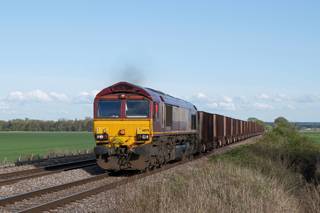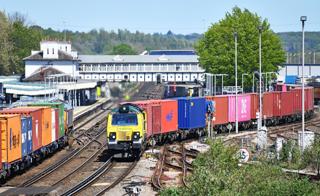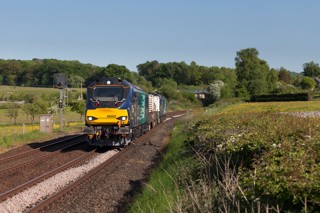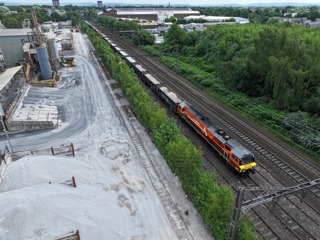Since 2016, the transport sector has been the largest contributor to the UK’s carbon dioxide emissions. Although there have been modest decreases (1.4% in 2018 and a further 2.8% in 2019), transport’s share of the UK’s carbon dioxide emissions has risen to an estimated 34% overall in 2019, due in large part to the energy sector significantly reducing its emissions.
Data for 2018 shows rail accounted for 1.4% of total UK territorial transport carbon dioxide emissions, aviation for 1.2%, and road 90.8% (see Further Reading 1). Overall transport emissions are only 3.0% lower than in 1990, as increased road traffic has largely offset improvements in vehicle fuel efficiency (see Further Reading 2).
Rail is firmly committed to playing its part in the UK’s efforts to combat climate change and contributing to deliver net zero greenhouse gas emissions by 2050.
But why is this target so important, why is the railway’s contribution key, and how does this translate into a vision for a low-carbon railway in 2050?
To understand the answers to these questions, it is necessary first to set the scene for why 2050, which is rooted in international agreements and written large in UK legislation, is such a key date.
We explain the statutory targets the UK Government has set to deliver its commitments under these agreements, and why these vary across the UK.
We then explore the major decisions, actions and commitments that the GB railway has committed to and must implement.
Finally, we look at what this might mean for the way the GB railway will look and operate in 2050.
2050 net zero target
It is now beyond all reasonable doubt that climate change is taking place at rates beyond almost anything known in the geological record, that human activities are a major contributor, that these changes have a disproportionate impact on poorer and developing nations, and that the consequences of unmitigated climate change would be catastrophic on a global scale.
The international consensus on climate change and related agreements have been developed through a succession of COPs (Conferences of the Parties), convened over the past three decades since climate change was first accepted as an imminent global crisis.
COP21, held in France in 2016, produced the Paris Agreement - a legally binding international treaty on climate change.
COP26 will take place in Glasgow in November this year, hosted by the UK Government. Delegates representing governments from around the world will be seeking to agree the next phase of climate action.
The Paris Agreement (see Further Reading 3) was adopted by 196 parties on December 12 2015 and entered into force on November 4 2016. Its goal is to limit global warming to well below 2°C, preferably to 1.5°C, compared with pre-industrial levels. To achieve this long-term temperature goal, countries aim to reach global peak greenhouse gas emissions as soon as possible in order to achieve a climate neutral world by mid-century.
In May 2019, the statutory advisor to the UK Government - the Committee on Climate Change (CCC, May 2019) - published Net Zero, the UK’s contribution to stopping global warming (see Further Reading 4).
This was prepared in response to a request from the ministers of the UK, Scottish and Welsh Governments responsible for climate change, for advice on when the UK and its devolved administrations should set and (as determined) reach a net zero greenhouse gas (GHG) or carbon target.
The report’s key findings (see Further Reading 5) were:
■ The UK should legislate as soon as possible to reach net-zero greenhouse gas emissions by 2050.
■ Wales should set a target for a 95% reduction in emissions by 2050 relative to 1990 levels of GHG emissions.
■ Scotland has proportionately greater potential for emissions removal than the UK overall, and can credibly adopt a more ambitious target. It should aim for net-zero GHGs by 2045.
A net-zero GHG target by 2050 (i.e. a 100% reduction from baseline 1990 levels) corresponds with the latest climate science and would deliver on the commitment that the UK made by signing the Paris Agreement.
It is achievable with known technologies, alongside improvements in people’s lives, and within the expected economic cost that Parliament accepted when it legislated the existing 2050 target for an 80% reduction from 1990, in the Climate Change Act 2008.
However, this is only possible if clear, stable and well-designed policies to reduce emissions further are introduced across the economy without delay. Current policy is insufficient for even the existing targets.
Accordingly, on June 27 2019, the UK Government committed to a legally binding target to achieve net zero greenhouse gas emissions by 2050.
The freight context
Overlapping the production of the CCC report, in 2017 the UK Government asked the National Infrastructure Commission to advise on the move to a low-carbon national freight system.
In its report published on April 17 2019 (see Further Reading 6), the NIC reached the conclusion that “through the adoption of new technologies and the recognition of freight’s needs in the planning system, it is possible to decarbonise road and rail freight by 2050”, and that this would require “government to outline clear, firm objectives”.
The Commission also recommend that: “Road and rail freight should have a common, single target to decarbonise fully by 2050. No part of the freight system should be indirectly subsidised by being allowed to emit carbon when other parts are decarbonising.”
The NIC pointed out the challenges for rail freight decarbonisation, noting that all options are likely to be expensive and probably entail significant technical challenges.
It noted that the alternative - to transfer it to other modes, most likely road - would also be costly and would likely require significant new road infrastructure, which would entail its own significant cost and social consequences.
The rail decarbonisation challenge
On February 12 2018, then Rail Minister Jo Johnson called for the rail industry to take “all diesel-only trains off the track by 2040” and to propose “a clear, long-term strategy with consistent objectives and incentives” with “ambitious and bold plans on decarbonising the whole rail sector”.
In response, the rail industry set up the Rail Industry Decarbonisation Taskforce, chaired by Angel Trains Chief Executive Malcolm Brown and comprising representatives from the major parts of the rail industry - including Network Rail, the Rail Delivery Group, the Rail Freight Group, the Railway Industry Association, and RSSB.
The purpose of the Taskforce was to prepare a collective response to the challenge - including a route map to delivering the mission, which will embed delivery in business as usual. It was remitted to look at decarbonisation across all aspects of the railway - including traction, property (stations, depots and other buildings) and infrastructure.
The Taskforce published two reports, in January and July 2019 (see Further Reading 7), which were accepted by the Minister for Rail and have since formed the basis for the railway’s ongoing response to the climate challenge.
The Taskforce concluded that decarbonisation would be best achieved with a balanced and judicious mix of cost-effective electrification, coupled with the deployment of targeted battery and hydrogen technology.
The reports were published not long after controversies about the high and increasing costs of certain electrification projects on the GB railway effectively led to the cancellation or indefinite delay of some major electrification schemes. While this was not a factor in the objective assessment of the benefits of different low-carbon traction options, it was inevitable that their findings and recommendations would be seen in that light.
RIA believed that the reasons why some electrification schemes had significantly overrun against budgets were neither systemic nor inevitable. It published the Electrification Cost Challenge (see Further Reading 8) in March 2019, to illustrate (with examples from the UK and internationally) how the high costs seen on recent projects, including the Great Western Electrification Programme, might be avoided in the future.
One of the ways is to implement a consistent programme of electrification at a constant rate, rather than the boom and bust programmes seen in recent years. This, alongside effective planning and design before starting projects, would enable demand, supply and costs to be held in much better balance than had often been the case with recent projects and programmes.
Electric, hydrogen and battery
The Technical Authority of Network Rail’s System Operator published the Interim Programme Business Case of the Traction Decarbonisation Network Strategy (TDNS) in September 2020.
Building on the work of the Taskforce and RIA (among others), the TDNS identified where different types of low-carbon traction might be most effectively deployed across the GB rail network. Figure 1 (below left) illustrates the suitability of different low-carbon traction options against rail service types.
By applying this approach to the 15,400 single track kilometres (STK) of unelectrified rail network in Britain, the TDNS proposed a split of electrification, battery and hydrogen (Figure 2, above).
Of the 2,300 STKs where “multiple options” could be delivered, operational and economic analysis has identified a further 1,340 STKs of electrification, battery operation over an additional 400 STKs, and hydrogen operation over an additional 400 STKs.
That leaves 260 STKs of infrastructure where no clear decision has yet been made, but a likely technology is identified within the TDNS National Recommendations document. Further work at a local level will be needed to confirm this.
Innovating at pace
Rail is at an exciting point of its journey as an industry. We have a national challenge to deliver a net zero emissions economy by 2050, and rail has committed to playing its part in delivering that target.
For the first time, there are credible options to deliver low-carbon rail services by means other than electrification. The understanding of how to deliver those options on a selective basis, in a manner which achieves the lowest whole life, whole system cost and carbon impact without compromising the ability to deliver services, is evolving fast.
The capability of the preferred non-electrification low-carbon options (hydrogen- and battery-powered trains) is progressing perhaps more rapidly than could have been expected even a few years ago.
This does not make them a substitute for electrification on high-speed, long-distance lines or for most freight routes, but it does offer genuine options for lines and services which play to the strengths of hydrogen and battery trains - the less busy rural lines where the range and speed of hydrogen trains is suitable, and lines with short hop, frequent stop services or lower running speeds where battery trains will be particularly effective.
The Government sees the railway as being an essential and integral part of a low-carbon, end-to-end transport system. DfT’s Transport Decarbonisation Plan consultation document (see Further Reading 9) projects a 60% increase in passenger demand from 2018 to 2050. While this was published pre-COVID-19, it is possible (as we discuss later) that passenger demand in 2050 may still reflect this long-term projection.
The ambition for public transport, including rail, is nevertheless clear: “Public transport and active travel will be the natural first choice for our daily activities. We will use our cars less and be able to rely on a convenient, cost-effective and coherent public transport network.”
The challenges ahead
Notwithstanding the opportunities that are opening up, there are some real challenges we must overcome to achieve rail’s contribution to net zero emissions in 2050. We can group these loosely into four main areas.
■ 1: Electrification is expensive, requires significant infrastructure, and has to be maintained.
We know this already, of course, but we should not allow ourselves to forget this when debating options. Delivering the extent of electrification identified in the TDNS interim business case will require very significant investment consistently applied over 30 years.
It will come as no surprise if we point out that there will be many demands on the public purse as we recover from the COVID-19 pandemic, so expectations as to the quantum and timing of funds for electrification will have to be managed.
■ 2: The profile of rail usage, for passengers in particular, is uncertain. We will discuss the long-term implications in more detail later when we look at the 2050 vision, but it will be essential to understand on a short to medium-term basis - in revenue, funding and patronage terms as the railway recovers.
■ 3: Britain’s railway is a mixed use, passenger-prioritised system. This means that while we can model ideal freight scenarios which may look encouraging for the possible use of hydrogen and battery traction, in practice the picture is (and is likely to remain) very different.
Even on a network where the main line is electrified, freight will be constrained if branch lines, passing loops and sidings are not electrified.
Freight is further limited in its commercially realistic options by the fact that trains on the GB network are length limited. Even if it proves feasible to power freight trains with an additional hydrogen or battery tender, if this removes a revenue-earning vehicle this may render the arrangement unviable.
In addition, at terminals, swapping a locomotive and tender from one end of the train to the other is a different proposition from simply swapping a locomotive. Space limitations on some sites may even render this impossible.
■ 4: While most rail tracks on (or accessible from) the main GB rail network are owned and managed by Network Rail, not all are. These ‘last mile’ sections are often critical elements, particularly for the freight network.
Freight terminals, ports and other facilities may not ever be able to electrify using 25kV AC overhead lines, due to (for example) operating constraints and safety issues.
Even if we can electrify the main line between these end points, there will be a need to have a secondary on-board power source, shunting arrangement or similar to move trains. These end points may be only a tiny fraction of the total journey, but the need for a secondary power source may dictate major design considerations for locomotives and powered passenger vehicles.
We’ve focused our discussion very heavily on traction options. This may look a little off, given that a recent report on the GB railway’s carbon footprint infers that around 55% is derived from embodied carbon. This will be tied up in the rail lines, the power supply infrastructure, signals, communications, stations, depots, train manufacture, road vehicles and so on.
However, a great deal of the variable carbon element of future infrastructure is likely to depend on traction options, so for the purposes of setting our possible 2050 visions in this paper (there is more than one!), this is a reasonable approach to adopt.
Research and collaboration
We have a very active research programme across the rail industry. As Network Rail is the owner and operator of most of the fixed assets that make up the railway, it clearly has a key role to play. However, the Decarbonisation Taskforce also includes representation from passenger and freight train operators, rolling stock companies, manufacturers, contractors, policy makers, and standards setters.
Decarbonisation demands that we work as an industry. Individual organisations must recognise that they are contributing, on a competitive, collaborative and co-operative basis, to realising industry ambitions, commitments and targets.
This demands the development of expertise, skillsets and competencies that have either not been used to any great extent on the railway or which have to be adapted to support the decarbonisation agenda.
Industry-level decarbonisation research since the publication of the Taskforce report has been focused on establishing baselines.
We have developed a more accurate industry carbon footprint, with a better understanding of where carbon impacts lie and who controls or can influence them.
We are developing guidance and advice on appropriate targets and decarbonisation pathways, which will influence the way that rail entities are challenged to contribute to industry decarbonisation efforts.
We are also exploring what incentives, including options from outside the rail industry, might be used to encourage decarbonisation in a coherent and cost-effective manner.
Other research has identified the steps needed to establish routes into service for battery and hydrogen trains, as well as the likely infrastructure requirements and costing models for hydrogen and battery fuelling/charging facilities based on where these trains are most likely to be deployed.
In future research work across the industry, we are likely to be seeking ways to integrate some of our prior work and known challenges to better understand aspects such as the distributed power supplies likely to be required from an increase in renewable energy generation, upskilling key personnel in carbon management, competencies and standards, carbon, route and network modelling. We will also need to focus on the practical aspects of freight in particular. Figure 3 (above) illustrates these possible areas of focus.
We will continue to evolve and adapt these areas of research as our understanding improves of the immediate and long-term needs to support industry decarbonisation.
2050
So, what does this all tell us about how a low-carbon railway in 2050 might look?
We have, up to now in this article, sought to root our arguments in a well-referenced narrative based on public policy, industry strategic documents and practical research. This is giving us a good idea of the practical, financial and carbon impacts of likely pathways, but cannot tell us how the railway of 2050 might be used.
Events in 2020 and early 2021 open up intriguing and fundamentally different possibilities. We need to ensure that the work we are doing now on rail decarbonisation is sound and adaptable - to allow both for what we expected pre-pandemic and for what could happen in the light of how society might change, and how we work, live and play as a result of what the pandemic has triggered.
There are two main versions of the future opening up as a result of lessons being offered in how society has responded to the COVID-19 pandemic. Please note that we are creating a vision here, rather than seeking to estimate the financial implications of specific options. However, there is no reason why one option should be any less viable than the other.
2050 Version 1: After a period, the railway recovers to regain the trajectory of traffic growth projected before the pandemic occurred.
This may take two years, five or ten. But if this happens, in 2050 we would be dealing with a railway handling the demands on which the original Transport Decarbonisation Plan assumptions are based. It will be a railway designed to meet peak morning and evening commuter flows, but which is not optimally utilised the rest of the operating day.
Depending on how this is estimated, this means that overall utilisation of passenger trains may be less than 40% (as is the case now), while peak loading on busy lines will continue to place major stresses on the travelling passengers and the rail operating system.
We will have a fantastic asset that is now running all (or almost all) passenger services without recourse to diesel or any other fossil fuel.
We will have completed or nearly completed all the electrification envisaged as possible in the Traction Decarbonisation Network Strategy, but we know that we have not yet been able to fulfil the vision set out in the Transport Decarbonisation Plan of rail being part of the natural first choice travel option as part of “a convenient, cost-effective and coherent public transport network”.
We will not be running the most sustainable railway possible, as we will still be carrying around too much air in vehicles rather than maximising the fixed assets inherent in our infrastructure.
We will have largely fulfilled the decarbonisation challenge, but perhaps have still to get fully to grips with the operational efficiency challenge at a system level.
2050 Version 2: The alternative is a rail system that is much less ‘peaky’ in its passenger usage, driven by a realisation that not all work has to be done face to face.
There are times when personal contact and interaction is critical and people need to travel to work, but there is also a recognition that some tasks and jobs do not need a person to travel to a central location. They can work from home or from a local workplace, thus staying in much closer ongoing contact with the places in which they live, their core communities and recreational spaces.
Or maybe the occasions needing face-to-face interaction are concentrated into two or three days, with the remainder of the time spent more remotely.
This railway does not have to be planned, resourced and managed to cope with the absolute peaks of our first vision for 2050, where we know that for the rest of the operating day it is running at much less than capacity.
This version instead reflects the way we live and work, as part of a national transport system led by public transport built and operating to serve the decentralisation of workspaces, outside the heavy concentrations in major urban areas that drive our peak demand flows.
Integral to the way that we make our travel choices is a change in a fundamental question, from “What time do I need to be in the office every day?” to “Do I need to make this journey? And if I do, do I need then to be in the office the rest of the day?”
This second version offers the potential for a much more efficient use of an expensive sunk investment in rail infrastructure.
It removes waste from the system by not creating the demand in the first instance, as well as using the system much more efficiently when it is being used. It also presents the potential for increased equity of access between passenger and freight.
This demands a fundamental rethink of our relationship with work, living and leisure spaces - most of which is outside the direct control of the railway.
In both cases, we can see the prospect of a railway that has adapted between now and 2050 to embrace technological change in traction options and associated infrastructure.
It has accepted the challenge laid down in 2018 to target carbon emissions in all areas of its activity, as well as in its supply chains.
It has embraced the green energy revolution by innovating the use of renewable energy generation on rail land, by making trains more energy-efficient and by improving building energy performance.
It is using the available capacity on a network where all intensively used lines are electrified and where hydrogen, battery and possibly other forms of low-carbon traction are deployed.
It has found ways to accommodate difficult to decarbonise freight transport - in some cases by prioritising freight on certain routes at certain times, and in other cases by the use of electric bi-modes where the alternative traction option is adequate for running on non-electrified track. It may be that some forms of liquid fuel are still in use, but dual fuelling has been effectively introduced to maximise the decarbonisation of trains in use.
In both cases, we can also see that the railway has not focused on carbon to the detriment of other factors that improve the quality of life for people, wildlife and the natural environment.
We have taken into account the social value of decarbonisation, the intimate relationship of carbon management and air quality on the railway, and the way that the railway is carbon-efficient not only in its own right, but also as part of end-to-end journeys for commuting, business and leisure.
2020 was the first year of a decade to the crucial 2030 deadline identified by the Inter-governmental Panel on Climate Change (IPCC). This is ‘the decade to make a difference’: humanity must press ahead with efforts to decarbonise and it is fantastic to be supporting rail in pursuit of sustainability.
We look forward to working with leaders from across the sector to deliver a net-zero railway.
- For more information about any of the subjects raised in this article, please email: [email protected]
















Login to comment
Comments
No comments have been made yet.